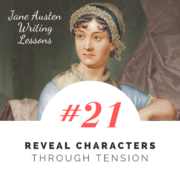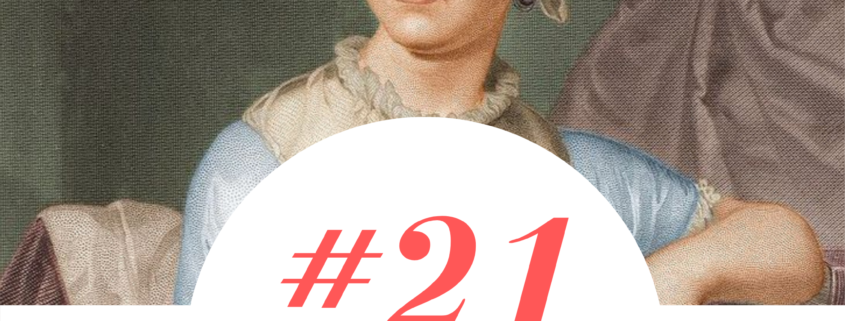Full Sized Blog Element (Big Preview Pic)
#21: Reveal Characters Through Tension
/0 Comments/in Jane Austen Writing Lessons/by Katherine Cowley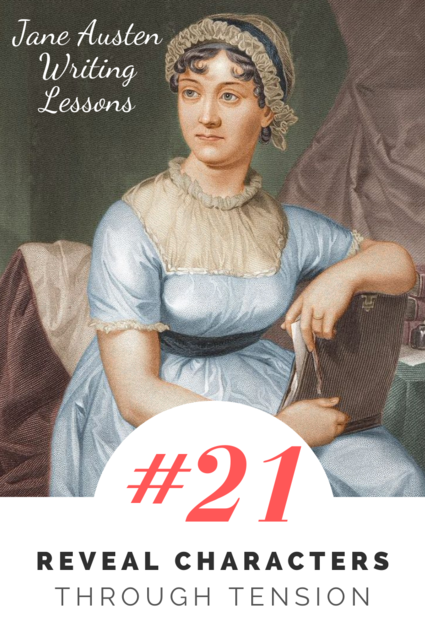
There are countless blog posts and books which give step-by-step guides on how to create a good first impression. In stories too, characters have first impressions of each other which can have a huge impact on their relationships and the plot (the original version that Jane Austen wrote of Pride and Prejudice was actually titled First Impressions.)
Yet another way to think about first impressions is the first impressions that characters leave on the reader. Whether a character is major or minor, whether they are introduced at the beginning of the book or near the end, our first impressions of characters begin the process of revealing them to us.
Revealing Characters to the Reader
But how do you reveal character, and how, as a writer, do you make sure that you leave the right first impression on readers? (Unlike in meeting people in real life, in a novel the goal is not necessarily to leave the best first impression, but rather, a first impression that helps us understand the essence of someone’s character, and often foreshadows their journey or the role that they will play in the story.)
One of the fastest ways to truly know someone is to see what they do and how they act in moments of struggle or tension. It is these moments that often draw out or reveal true or fundamental character. (I remember receiving very similar dating advice—you want to make sure that you see the person you are dating in hard or challenging situations, not just good ones.)
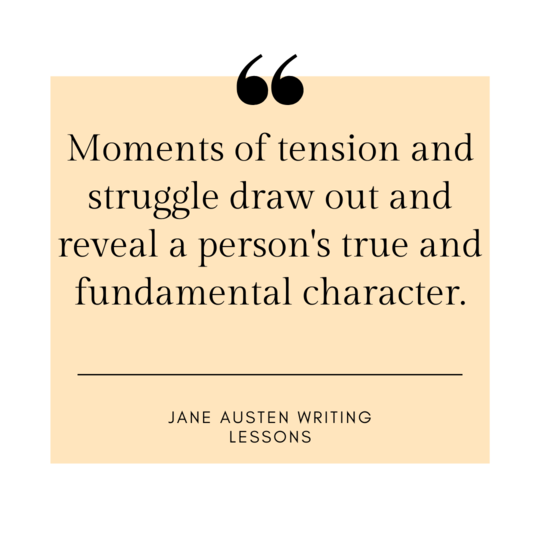
In Northanger Abbey, the narrator introduces us to Catherine Morland in the first chapter, but the first time we see Catherine Morland in scene rather than summary is in Chapter 2.
Catherine has just arrived in Bath, where she is staying with her friends, Mr. and Mrs. Allen. They go to a public ball, and unfortunately, they do not know anyone. Mr. Allen immediately goes off on his own, leaving Catherine and Mrs. Allen to fend for themselves.
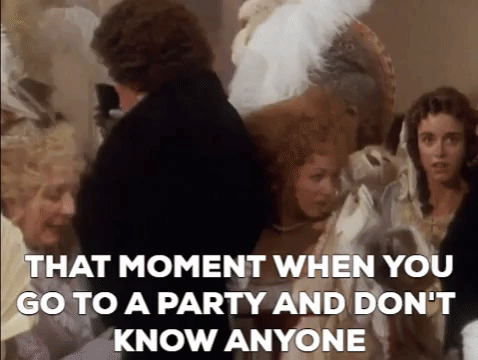
Gif from the 1987 film adaptation of Northanger Abbey
“How uncomfortable it is,” whispered Catherine, “not to have a single acquaintance here!”
“Yes, my dear,” replied Mrs. Allen with perfect serenity, “it is very uncomfortable indeed.”
“What shall we do?—The gentlemen and ladies at this table look as if they wondered why we came here—we seem forcing ourselves into their party.”
“Ay, so we do.—That is very disagreeable. I wish we had a large acquaintance here.”
“I wish we had any;–it would be somebody to go to.”
Jane Austen has efficiently and effectively revealed key elements of Mrs. Allen’s and Catherine’s characters.
First, Mrs. Allen:
- Mrs. Allen does not take action, even when she sees that her companion, who is relying on her to take the lead, is uncomfortable.
- She has “perfect serenity” which can either demonstrate a great Zen state and that she is not bothered by outside influences and struggle—or this could demonstrate a lack or failing on her part.
Next, Catherine:
- Her wants are revealed—she wants to know people, she wants to dance and have a good experience, she wants to feel comfortable in her surroundings.
- She is currently more passive than active. She lets others control or dictate her actions (which is something that will become an important plot point later).
- She is a sympathetic character, an underdog, and we want her to succeed.
- She is concerned about propriety and her place in society. While one of the things Catherine must learn over the course of the novel is how to read people and situations, she isn’t starting from nothing.
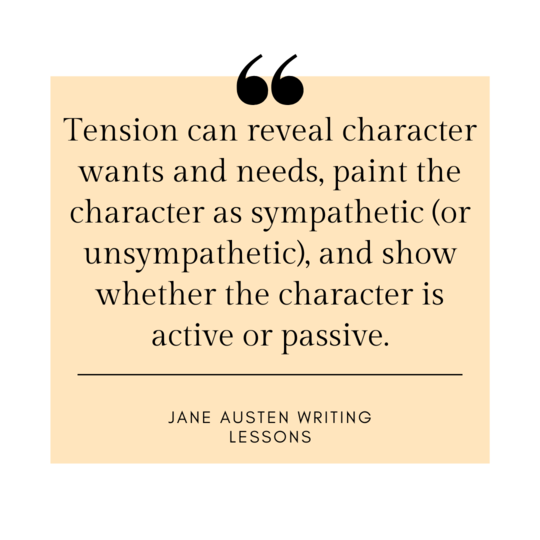
Later in the scene, near the end of the ball, Mr. Allen returns:
“Well, Miss Morland,” said [Mr. Allen], directly, “I hope you have had an agreeable ball.”
“Very agreeable indeed,” she replied, vainly endeavouring to hide a great yawn.
This brief exchange reveals more about Catherine:
- She is more open with Mrs. Allen than Mr. Allen
- Mr. Allen is unaware of the situation
- She is kind and considerate. She is not a complainer or whiner, and tries to put a good spin on things, even as she fails to suppress a yawn. This is endearing and makes her more sympathetic.
- The chapter closes with everyone leaving, and with Catherine’s attempt to frame her own experience:
She was looked at, however, and with some admiration; for, in her own hearing, two gentlemen pronounced her to be a pretty girl. Such words had their due effect; she immediately though the evening pleasanter than she had found it before—he humble vanity was contented—she felt more obliged to the two young men for this simple praise than a true quality heroine would have been for fifteen sonnets in celebration of her charms, and went to her chair in good humour with everybody, and perfectly satisfied with her share of attention.
This paragraph is brilliant, because Catherine begins this scene with struggle: she is stressed and worried, and yet this final paragraph shows that she is not one to be crushed.
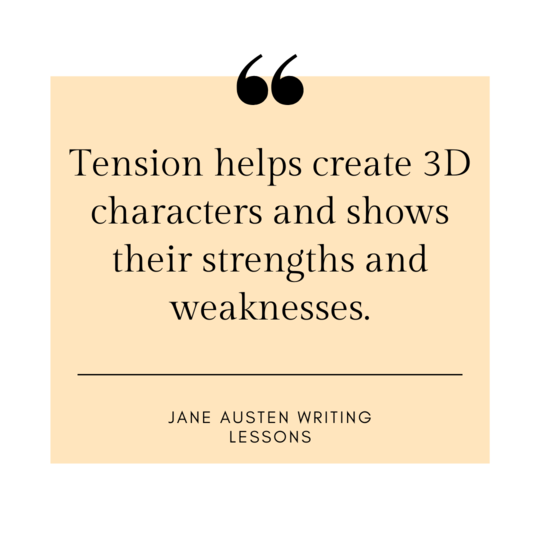
Catherine is both naïve and optimistic, inexperienced and loveable. In just this short scene, Austen has managed to set up some of the core tensions that make Catherine a three-dimensional character whose story is worth following.
One of the biggest advantages of using a moment of tension or challenge to reveal character is that is demonstrates characters’ strengths and weaknesses, and it sets the stage for the tools and limitations that will accompany them on their journey. As characters are pushed and pulled by outside and inside forces, we see what they are really made of.
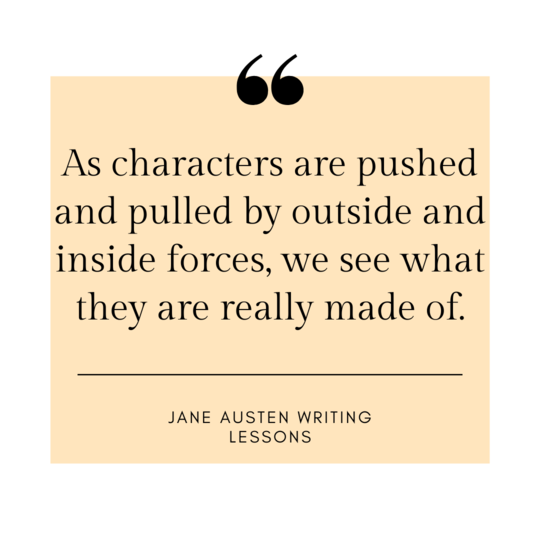
Struggle or tension can manifest in numerous forms, including:
Two characters wanting different things
A small or large problem
A lack or a need that is manifest in a particular situation
A change in situation that tests or challenges a character
A goal or task which is challenging and requires effort
These scenes are effective not just for the first time we meet a character, but throughout the story. If you want to show a character’s change or growth, then do it in a scene that has tension or struggle.
Sometimes you may also want to intentionally write a character that has given of a false first impression to the reader, that disguises their true character (even while containing hints of it). In this case, have moments of tension later that reveal their true character to the reader.

Exercise 1: Choose a novel or short story and print a copy of the first moment of tension, struggle, or challenge for the character. Now, find and print a copy of the last big moment of tension or struggle for this character in the novel (this is often but not always during the climax).
Mark up these scenes, underlining and annotating with what reveals character (wants, needs, multidimensional, strengths/weaknesses, active/passive, sympathetic/unsympathetic). Compare these scenes and how the character has changed throughout the course of the novel. How does the first scene of tension and struggle set up the final scene of tension and struggle?
Exercise 2: Jane Austen is a master of creating tension and struggle from small, everyday moments, and using this tension to express and develop character. List five everyday objects from the same category (i.e. kitchen items, toys, technology, apparel). Write a short scene which includes at least two of these objects and which also uses tensions and struggle to reveal character.
Exercise 3: If you have a draft of a short story or novel, analyze what types of tension you use throughout the story. Is the tension or struggle manifested by:
- Two characters wanting different things
- A small or large problem
- A lack or a need that is manifest in a particular situation
- A change in situation that tests or challenges a character
- A goal or task which is challenging and requires effort
- Other
Do the sorts of struggles shift over the course of your novel? How does this affect the main character’s inner journey? Is the progression satisfying?
#20: Use Unsympathetic Characters Effectively
/0 Comments/in Jane Austen Writing Lessons/by Katherine Cowley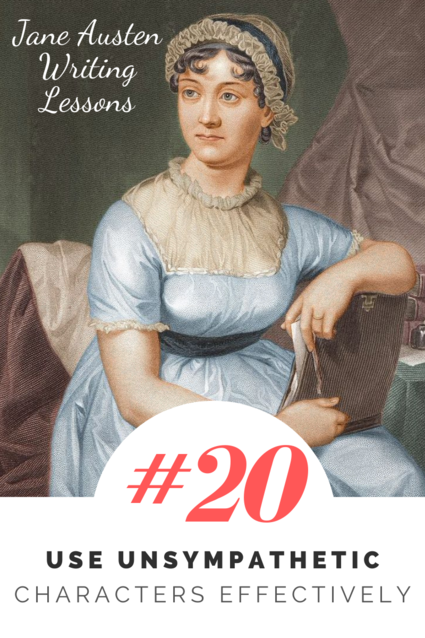
Last week, I wrote about how to create sympathetic characters, and why they are so useful. To make your characters unsympathetic, you often use the reverse techniques.
Here are some of the major techniques which create unsympathetic characters:
- Give the character unrelatable motives and actions.
- Give the character an unrelatable perspective (in the case of a non-viewpoint character, sometimes the things that form the character’s perspective—their background and their situation—are unknown to the reader, which makes it more likely that we will perceive the character and their choices as unsympathetic).
- Have the character act in unlikeable ways.
- Further, have the character be cruel, unkind, or selfish. Have them hurt others (we especially dislike when characters hurt a character, animal, or thing that we care about as readers).
- Make the character too perfect or too imperfect (or too miserable in their circumstances).
- Have the character not learn from their mistakes and forgo opportunities to improve.
- Make the character not self-aware.
Emma (in Jane Austen’s novel of the same title) is a great example of an effective unsympathetic character. It is challenging to write an unsympathetic main character who routinely takes actions that the reader disagrees with—yet Austen has done so in a way that keeps us engaged and even rooting for Emma.

Gif of Emma from the 2020 film
The techniques Austen uses are useful whether you’re writing an unsympathetic protagonist, antagonist, or supporting character, and they are also useful if you are making a largely sympathetic character unsympathetic for a portion of the story.
Unsympathetic Character Feature: Emma
Emma is Jane Austen’s only heroine that is truly, undeniably rich. At the beginning of the novel, her governess marries, and she is left alone with her father. She befriends Harriet Smith and tries to teach her to be more refined.

Yet Harriet is in love with a Mr. Martin, and even though he is respectable and owns his own land and could make Harriet happy, Emma is opposed to the match, and she justifies this opposition by claiming that Mr. Martin is beneath Harriet in status (however, as Mr. Knightley points out, this is not actually the case).
As Harriet and Emma are walking one day, they see Mr. Martin, and Harriet speaks with him briefly. After, an excited Harriet asks Emma:
“Well, Miss Woodhouse, is he like what you expected? What do you think of him? Do you think him so very plain?”
“He is very plain, undoubtedly—remarkably plain:—but that is nothing, compared with his entire want of gentility. I had no right to expect much, and I did not expect much; but I had no idea that he could be so very clownish, so totally without air. I had imagined him, I confess, a degree or two nearer gentility.”
“To be sure,” said Harriet, in a mortified voice, “he is not so genteel as a real gentleman.”
Emma’s words hurt Harriet, but because Emma is highborn and sophisticated and well-spoken, Harriet does not protest. A few chapters later, Mr. Martin proposes (via letter) to Harriet, and Emma convinces Harriet to turn him down (though she does it in a way that forces Harriet to make the decision as if on her own). These are unsympathetic actions which derive from faulty judgement and selfish motives (wanting to keep Harriet to herself). Though we understand Emma’s perspective, we are not meant to relate to it, and instead, we latch on to Mr. Knightley’s criticism of Emma’s behavior.
Note: A key to writing an unsympathetic character is that this character must believe that their motives and actions are good/necessary/justified. In Emma’s mind, she is doing what is best for Harriet and saving her friend.
Emma’s Redeeming Qualities
Though Emma consistently does unsympathetic things, we keep reading because of her redeeming qualities:
- She is witty and intelligent
- She can be humorous (and the narrator is particularly funny)
- In general, the people in her community like her
- She is active and engaging
All of these redeeming qualities give us some level of sympathy for Emma, which brings me to my next point: unsympathetic characters should still have sympathetic qualities.
Even though her judgment can be faulty and her actions unkind, sometimes she has better judgment and shows a stronger awareness of the needs and desires of others. For instance, Emma’s father hates marriage and is upset that Miss Taylor has become Mrs. Weston:
Poor Miss Taylor!—I wish she were here again. What a pity it is that Mr. Weston ever thought of her!”
“I cannot agree with you, papa; you know I cannot. Mr. Weston is such a good-humoured, pleasant, excellent man, that he thoroughly deserves a good wife;–and you would not have had Miss Taylor live with us for ever and bear all my odd humours, when she might have a house of her own?”
We can become invested in unsympathetic characters when they are more sympathetic (in one or more areas) than their fellow characters.

Emma’s Self-Awareness
If Emma was completely self-aware, she would realize the full, sometimes terrible consequences of her actions.
Yet she shows a certain level of self-awareness. This can be seen as she talks about, thinks about, and interacts with Jane Fairfax, a long-time acquittance who has come to stay in Highbury. Here’s an excerpt from a rather lengthy passage (bolding is my own):
Emma was sorry;—to have to pay civilities to a person she did not like through three long months!—to be always doing more than she wished, and less than she ought! Why she did not like Jane Fairfax might be a difficult question to answer; Mr. Knightley had once told her it was because she saw in her the really accomplished young woman, which she wanted to be thought herself; and though the accusation had been eagerly refuted at the time, there were moments of self-examination in which her conscience could not quite acquit her. But “she could never get acquainted with her: she did not know how it was, but there was such coldness and reserve—such apparent indifference whether she pleased or not—and then, her aunt was such an eternal talker!—and she was made such a fuss with by every body!—and it had been always imagined that they were to be so intimate—because their ages were the same, every body had supposed they must be so fond of each other.” These were her reasons—she had no better.
It was a dislike so little just—every imputed fault was so magnified by fancy, that she never saw Jane Fairfax the first time after any considerable absence, without feeling that she had injured her; and now, when the due visit was paid, on her arrival, after a two years’ interval, she was particularly struck with the very appearance and manners, which for those two whole years she had been depreciating. Jane Fairfax was very elegant, remarkably elegant; and she had herself the highest value for elegance.
Emma is aware of her own unfairness, and she is aware that her “dislike [is] so little just.” Yet as the scene progresses, she continues to justify her negative behavior and actions towards Jane based on perceived faults:
She was, besides, which was the worst of all, so cold, so cautious! There was no getting at her real opinion. Wrapt up in a cloak of politeness, she seemed determined to hazard nothing. She was disgustingly, was suspiciously reserved.
Even though we cannot completely condone Emma’s behavior and attitude, she does become more sympathetic as we are immersed in her perspective.
Reasons to Create an Unsympathetic Character
There are many reasons that you might want to create an unsympathetic character:
- To make it clear that the narrator (and/or the author) does not agree with or condone the character’s actions and behavior. (If this is one of the goals, it’s often useful to have a character like Mr. Knightley in Emma who criticizes or calls the character out on their behavior.)
- It’s a powerful way to create tension, drama, and conflict.
- Controlling and shifting the reader’s sympathies can create a powerful emotional reaction for the reader.
- Humans do unsympathetic things all the time, and it’s interesting and compelling to explore this aspect of humanity in literature.
- An unsympathetic main character has a greater potential to grow and change.
- For characters that are largely sympathetic, having scenes where they are unsympathetic can create contrast with and help build to key scenes where the character makes admirable, sympathetic choices that we can really root for (the cartoonist Howard Tayler talks about these as “stand up and cheer” moments).
Emma’s internal journey is about her rethinking her place in the community and learning to be kinder and let others choose what is best for themselves. She shows tremendous growth over the novel, and it’s largely made possible through her being an unsympathetic character.

Exercise 1: Who is your favorite unsympathetic character? This could be a protagonist, an antagonist, or a supporting character. Why are they unsympathetic? And why do you like them?
Exercise 2: Take a classic fairy tale character that is generally sympathetic (i.e. Cinderella). Write a scene which makes this character unsympathetic to the reader. Remember to temper the character and give them some redeeming or positive qualities.
Exercise 3: Different techniques for unsympathetic characters can create very different effects. Take one of your characters—this could be a new or an existing character. Now choose three of the following techniques you could use to make them unsympathetic:
- Give the character unrelatable motives and actions.
- Give the character an unrelatable perspective.
- Have the character act in unlikeable ways.
- Further, have the character be cruel, unkind, or selfish. Have them hurt others (we especially dislike when characters hurt a character, animal, or thing that we care about as readers).
- Make the character too perfect or too imperfect (or too miserable in their circumstances).
- Have the character not learn from their mistakes and forgo opportunities to improve.
- Make the character not self-aware.
For each technique you choose, brainstorm a scene that could use this technique to make the character unsympathetic. (If you’d like to take it one step farther, you can write these scenes.)

